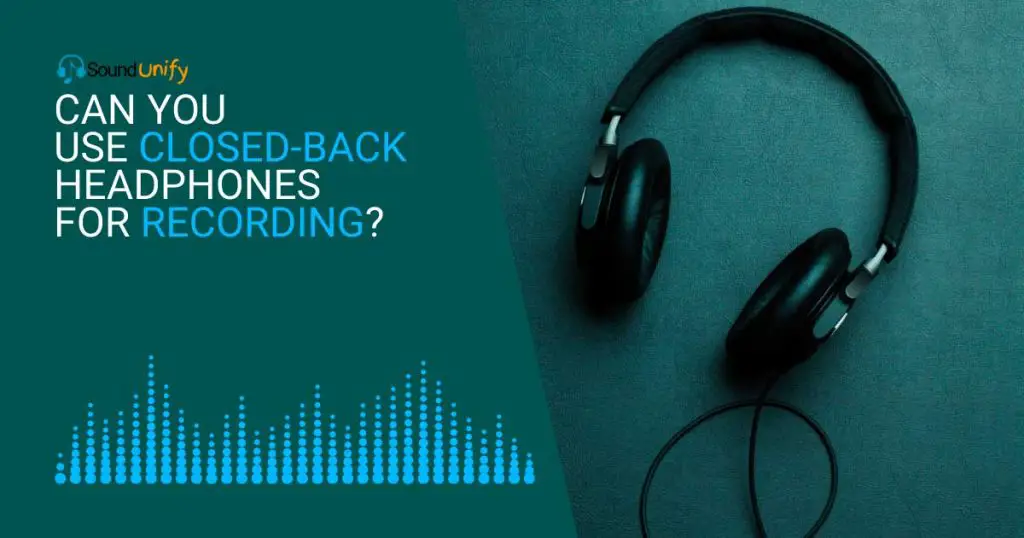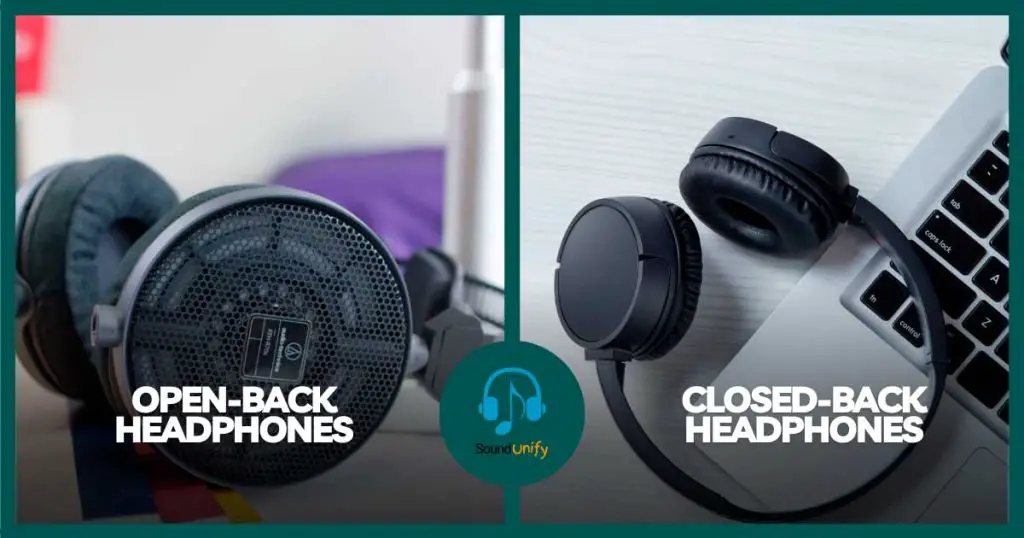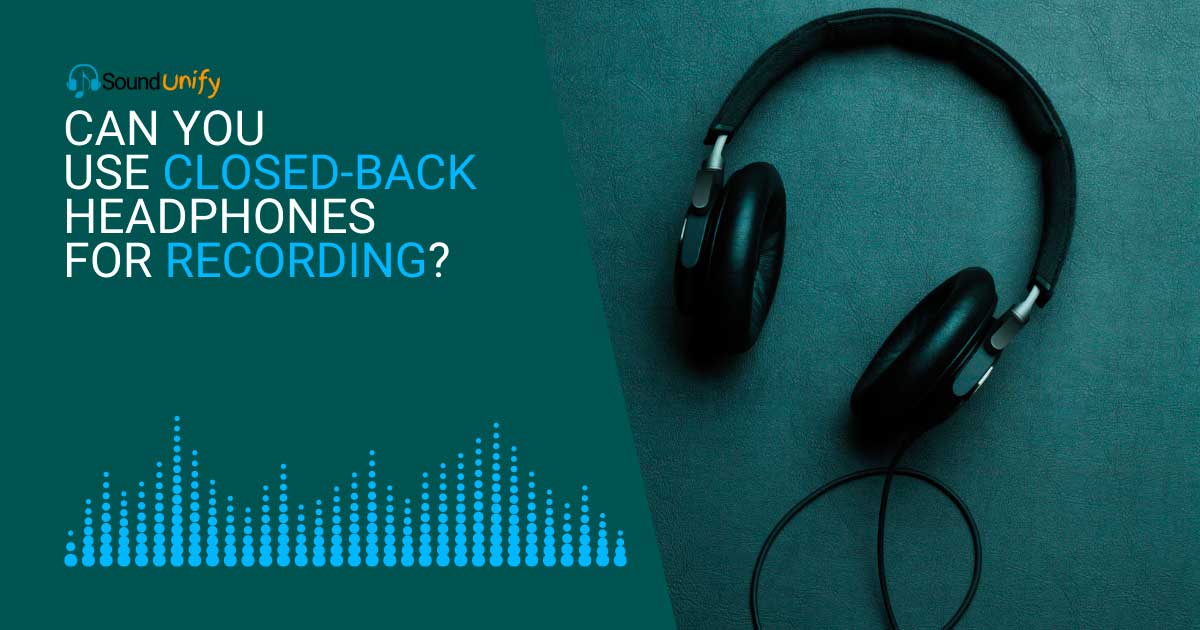When it comes to music production and recording, having the right equipment can make a massive difference in the quality of your work. Headphones are essential for any audio engineer or music producer, but how do you know which type best suits your needs?
Closed-back headphones have been around for decades and have become increasingly popular among producers and sound engineers due to their unique sound profile and ability to isolate outside noise.
This article will explore why closed-back headphones are so ideal for recording, what makes them different from open-back headphones, and some of the best closed-back headphones available on the market today.
Can You Use Closed-Back Headphones for Recording?

Closed-back headphones can be great for recording audio, depending on your sonic needs. With the proper setup, they can help create an isolated listening environment and minimize sound bleed.
When choosing closed-back headphones, it’s important to consider factors such as sound quality, comfort, and desired isolation level. Additionally, comparing open-back and closed-back headphones can help you determine the best choice for your recording.
Basics of Recording Audio Using Headphones
Recording audio using headphones is a common practice in the music industry. With headphones, it is possible to capture an accurate and detailed representation of the sound recorded. This makes it easier to mix and edit the sound later on, as you can hear the nuances in the recording more clearly.
When choosing headphones for this purpose, there are two main types:
- open-back headphones
- closed-back headphones
Open-back headphones have vents in their ear cups to allow airflow between your ears and the outside environment. This can create a more natural soundscape and allow ambient noise into your recording if not appropriately controlled.
Closed-back headphones have sealed ear cups that prevent ambient noise from coming in or out. This provides a more isolated listening experience that gives you better control over what sounds get recorded.
Differences Between Open-Back and Closed-Back Headphones

Closed-back headphones are designed to seal the ear from the sound coming from the outside and keep the sound from leaking.
This design makes them excellent at blocking outside noise and providing a higher isolation level, which is why they are famous for recording audio. Open-back headphones do not completely seal off the ear and allow some sound to pass through.
The primary difference between open-back and closed-back headphones is their acoustic design. Closed-back headphones feature a solid back plate that encloses the driver and prevents sound waves from escaping or entering through the back side of the headphone cup.
As a result, they deliver tight bass response and improved isolation with minimal sound leakage. Open-back designs feature an open-air back plate that allows sound waves to pass through. This usually results in more natural-sounding audio with wider stereo imaging and more sound leakage.
When selecting headphones for recording audio, it’s important to consider both types of design: open-back and closed-back. If you need sound isolation from outside noise, closed-back models can ensure that only your desired sounds are recorded.
In contrast, open-back models may provide a more natural audio experience with less coloration of the original signal. Choosing between open-back or closed-back headphones is based on preference and your desired performance when recording audio.
Reasons Why You Can Use Closed-Back Headphones for Recording
Closed-back headphones are great for recording and music production because they provide superior sound isolation, allowing you to record without being distracted by outside noise. They have many more reasons to use them for recording.
- Preventing sound bleed can be a significant issue when recording in smaller spaces. Additionally, the tightly sealed design of closed-back headphones helps to create an accurate and natural representation of the audio you’re recording, allowing you to capture every nuance of the source material.
- Greater accuracy and interference protection: When recording, you don’t want any outside disturbances to affect your recording session. A closed-back design help ensure that your microphone does not pick up any external noise. It also helps reduce internal interference by preventing your headphone drivers from affecting each other.
- Increased comfort: Closed-back headphones are generally more comfortable than open-back headphones. This makes them ideal for longer sessions in the studio, where comfort is crucial.
- Better soundstage: The soundstage on closed-back headphones is typically larger and more accurate than on open-back headphones. This makes them great for scenarios such as music production and mixing when accuracy is essential.
- More control over sound levels: Closed-back headphones provide more control over sound levels, ensuring that you don’t experience any unwanted peaks or lows while recording. This makes them great for capturing a balanced and natural sound.
- Great for musicians: Closed-back headphones are great for musicians and sound engineers who prefer to focus on recorded music. These headphones allow them to hear the nuances in the music more clearly and accurately, meaning their performances and recordings are of a higher quality.
- Easier to acquire: Last but not least, closed-back headphones are much easier to acquire than open-back headphones. This means you can find a great pair of headphones for your recording and music production needs more quickly than with open-back headphones. This is especially useful for those on a budget.
Potential Drawbacks of Using Closed-Back Headphones for Recording
- When recording music with closed-back headphones, one of the potential drawbacks is that the sound may become too isolated and narrow, this can cause the audio to sound unnatural, as it may lack the natural ambiance of a room or studio space.
- Closed-back headphones often have higher background noise levels, which can add unwanted hiss or static to a recording. Some models also suffer from poor sound quality due to their tight fit on the ears, which can dampen specific frequencies and distort others. This means that they may need to hear low-end sounds clearly or accurately.
- Since closed-back headphones completely seal off your ears from their environment, it can make it more difficult to hear what’s happening around you and make adjustments if necessary. This can be particularly problematic if you’re working in a noisy environment and must keep track of external sounds while recording.
Tips for Getting the Best Sound Quality When Using Closed-Back Headphones for Recording
Several tips can help you get the best sound quality when recording with closed-back headphones.
- Ensure that the headphones fit snugly and securely over your ears. This will ensure that sound is not leaking out of the side of the headphones and into the microphone, which can cause distortion and other problems. Additionally, you should be aware of any background noise in the room when recording, as this can also interfere with your sound quality. Try to reduce or eliminate any unwanted sounds before you start recording.
- Test the sound quality before turning on any gear or recording software. It is important to know how different sounds register through your headphones to adjust levels accordingly during mixing and mastering processes later on. Pay attention to how low notes translate through the lows and how high frequencies come through in the highs or mid-range levels. With closed-back headphones, you should expect some degree of isolation from external noise, which will help create a more focused listening environment when recording vocals or instruments.
- Use a proper monitoring setup. It’s important to have a separate studio monitor or another pair of headphones on hand to hear what you’re recording accurately and make adjustments if necessary. This is especially important for more complex audio recordings, such as vocals and instruments, where subtle nuances can make a big difference in the final product.
- Choose high-quality closed-back headphones when recording. Cheaper models may not provide enough isolation from outside noise or accurate sound reproduction, which could negatively affect your recordings. Investing in a good pair of headphones can go a long way toward improving your sound quality and making sure every detail comes through clearly in your recordings.
- Experiment with settings such as equalization (EQ) or noise-canceling features. EQs can help sculpt your desired tone while providing extra clarity in specific frequencies. Similarly, noise-canceling technology can reduce unwanted outside noises that could interfere with your recordings. This feature could be beneficial when working in studios with other musicians present nearby.
Alternatives to Closed-Back Headphones for Recording
When it comes to recording audio, choosing the right headphones is essential. While closed-back headphones have advantages for recording, there are also some potential drawbacks.
In addition, many audio engineers prefer to use open-back headphones when recording to achieve a more natural sound and reduce the risk of any acoustic artifacts that can be created using closed-back models.
Fortunately, there are several alternatives to closed-back headphones that can still provide great results while avoiding the issues associated with them.
Use earbuds or in-ear monitors (IEMs)
Unlike closed-back headphones, earbuds and IEMs sit inside the ear canal and create an airtight seal.
This makes them excellent for isolating sound, as they block out external noise without creating additional acoustic artifacts.
Furthermore, because of their low profile design and lack of bulky ear cups around your ears, you’ll find them much more comfortable than traditional headphones.
Use a studio monitor speaker setup instead of headphones
You can get a wider soundstage than just a pair of closed-back headphones by positioning multiple speakers around the room in a “sweet spot” configuration.
This will allow you to hear subtle details in the mix that may lose with one set of cans alone.
Additionally, having multiple listening points in the room will enable you to focus on different areas simultaneously, which can help speed up your workflow significantly, especially during mixing sessions.
What Are Closed-Back Headphones Used For?
Closed-back headphones are often used for recording music and playing back mixes, as they reduce sound leakage and the sounds of outside noise. They are also commonly used by gamers, audiophiles, and people who want a more immersive listening experience.
- Gaming: Closed-back headphones provide good sound isolation and an immersive experience when playing video or computer games.
- Music Production and Mixing: Closed-back headphones are the preferred choice of many music professionals who need accurate audio reproduction on a budget. They are great for mixing and monitoring recordings.
- Audiophiles: Audiophiles often prefer closed-back headphones because of their ability to provide clear, detailed sound without any external noise interference.
- Everyday Listening: Many people looking for a more immersive listening experience prefer closed-back headphones as they offer better sound isolation and increase sound clarity.
- Calls and Video Conferencing: Closed-back headphones are an excellent choice for making calls and participating in video conferences as they provide good sound isolation and prevent background noise from interfering with the audio signal.
- Monitoring during tracking and mixing: They accurately represent the recorded or mixed sounds, which helps producers make informed decisions about levels, balance, and panning.
- Videographers and editors: Closed-back headphones are sometimes used by videographers and editors who need to monitor audio while editing footage. These headphones’ ambient noise reduction capabilities allow users to hear subtle nuances in their recordings while minimizing outside noise interference.
5 Closed-Back Headphones for Recording
There are some great options if you are looking for a good pair of closed-back headphones while recording. Closed-back headphones provide excellent sound isolation and can help you achieve better recording results than open-back headphones. Here are five options that we recommend for recording:
- Sony MDR7506: The Sony MDR7506 is a popular choice among studio professionals due to its superior sound quality and comfortable fit. It features a closed-back design with 40-millimeter drivers that deliver balanced audio across all frequencies.
- Audio Technica ATH-M50x: The Audio Technica ATH-M50x is a professional-grade studio monitor that provides exceptional clarity and accuracy. They feature large 45-millimeter drivers and circumaural ear cups to give your recordings an accurate representation of the source material.
- Beyerdynamic DT 770 Pro: The Beyerdynamic DT 770 Pro offers excellent sound quality in a lightweight design with plenty of bass response thanks to its powerful 55-millimeter drivers. These closed-back headphones also come with replaceable ear pads to keep them fresh even after long days in the studio.
- Sennheiser HD 280 Pro: The Sennheiser HD 280 Pro features dynamic. Closed-back ear cups are designed to block outside noise while providing clear audio reproduction without distortion or coloration caused by external noise sources such as other instruments or people talking in the background of your recordings. It also has an adjustable headband to ensure a comfortable fit for different head sizes and shapes.
FAQ
Why Are Closed-Back Headphones So Great For Music Production?
Closed-back headphones are much better for music production than open-back headphones because they provide an isolated listening experience.
This helps producers listen to their mix objectively, out of the context of the room, which can help spot any mistakes or flaws in the mix.
The headphones also reduce the bleed from the headphone speakers into the microphone while recording, which helps to keep the recording environment clean and consistent.
Do I Really Need Closed-Back Headphones to Record?
No, you don’t need closed-back headphones to record, but they will help. Open-back headphones can work just as well in the right situation, but closed-back headphones offer the most control and isolation. This makes them the preferred choice for serious audio production.
Do Closed-Back Headphones Have More Bass?
Yes, closed-back headphones typically have more bass than open-back headphones. This is because closed-back headphones provide a better seal around the ear, allowing more sound waves to be contained and heard instead of being lost in the open environment.
Closed-back headphones also provide a sense of isolation by blocking out external noise, making it easier to focus on low frequencies.
Do You Need to be Wired or Wireless Closed-Back Headphones?
The choice between wired and wireless closed-back headphones is a matter of personal preference. Wired headphones are more reliable and provide better sound quality since they don’t suffer from any latency issues or the potential for audio dropouts that wireless devices can have.
However, wireless closed-back headphones provide the convenience of portability. You can use them anywhere without worrying about cords or wires getting in the way. Ultimately, the choice is up to you as to which type of closed-back headphones is best for your needs.
Conclusion
It is possible to use closed-back headphones for recording, offering several advantages. Closed-back headphones help to create a more controlled environment with reduced sound bleed and better isolation. However, we must consider some potential drawbacks.
You can still achieve outstanding results by following simple tips and best practices for using closed-back headphones in a studio setting.
Understanding the differences between open-back and closed-back headphones is essential to make an informed decision when selecting the correct headphones for your recording needs.
James Dimento is a Chief-in-Editor of SoundUnify. He is a headphone enthusiast and creative writer passionate about audio technology. He has three years of experience writing about headphones and sound quality and is responsible for creating reviews and taking care of all administration.
